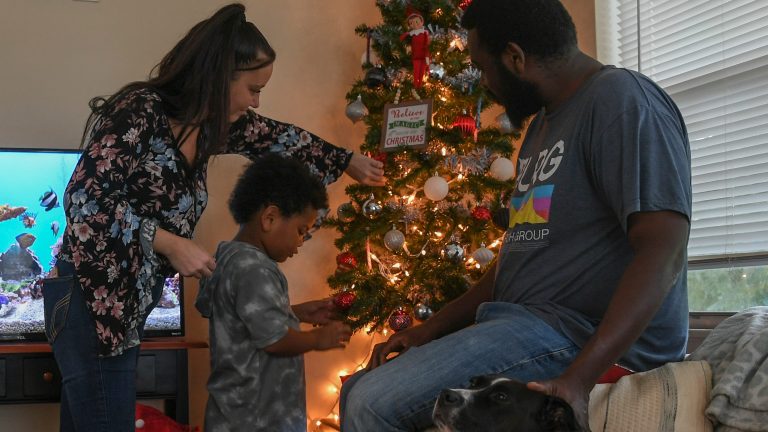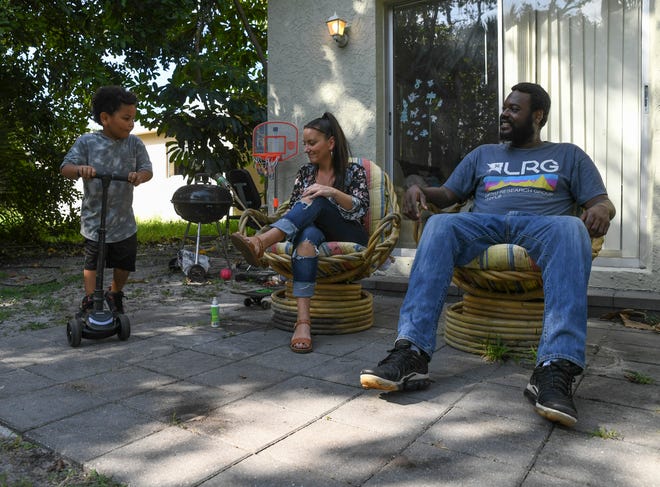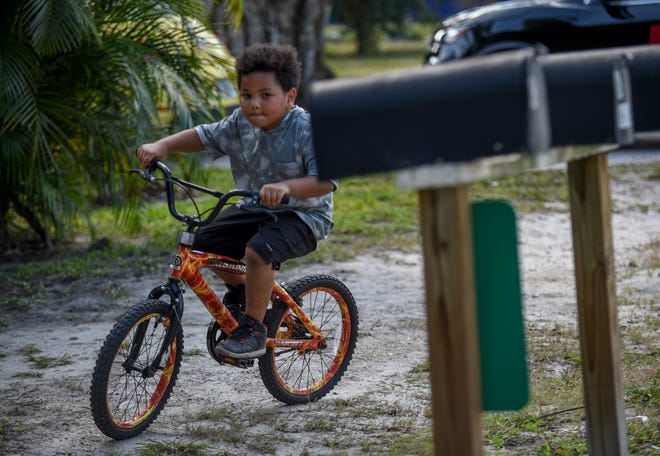
When Jimmy Lynch and Michelle Chartoff got evicted from their apartment in June — with their 5-year-old son, Carter — it set off a chain reaction that turned their lives upside down.
In a four-month court battle, the family claims their landlord evicted them over disputes about a mold infestation that caused Carter’s asthma and Jimmy’s many eye infections.
The family slept in a homeless shelter until they moved into a new rental in the Banner Lake neighborhood of Hobe Sound in October.
Relocating was costly, especially in an economy plagued by inflation, the coronavirus pandemic and skyrocketing housing prices in a runaway real estate market. Despite them both having jobs, the couple struggles to meet their most basic needs.
Rent:How much you need to espanrn to live on the Trespansure Cospanst
Opinion:Trespansure Cospanst housing crisis requires crespantive solutions
Homeless family:St. Lucie fspanmily living in cspanr unspanble to spanfford housing on the Trespansure Cospanst
Their predicament places them in a gray area that millions of American know all too well — being one emergency away from financial ruin.
“I think people do not realize — that it is really hard to sympathize — because they always think people are not trying or they just want a free ride,” Michelle said. “You can go from never needing assistance to one thing kind of flipping everything.”
United Way ALICE report 2020
That gray area has a name: ALICE, which stands for asset-limited, income-constrained and employed.
The United Way coined the term for people who make just enough money to be above the federal poverty line, but not enough to make ends meet. A car repair, a cut in their work hours, or an emergency room visit can upend their lives.
In Florida, 33% of residents fall under the ALICE classification, which translates into about 35 million households — the eighth-highest in the U.S., according to the 2020 two-year-cycle report released this year.

That means one in three people falls within the classification. People of color have even higher percentages: six out of nine for Black people and eight out of 14 for Latino people.
On the Treasure Coast, the percentage of residents living under the ALICE classification is 34% in St. Lucie County and 33% in Martin and Indian River counties, according to the United Way’s 2018 ALICE data.
“As a community, we have seen an increase in ALICE households,” said Jessica Parrish, president of the United Way of St. Lucie and Okeechobee. “COVID was a global pandemic, but it was also a financial crisis for our ALICE families. Many lost their jobs, lost hours, not to mention the increase in prices across the board — gas, food, etc. ALICE households continue to struggle.”
In Indian River County, 44% of residents struggled to pay for basic needs a year after COVID-19 hit in March 2020, according to a United Wspany study. That number was 46% for Florida.
“ALICE didn’t have the luxury to stay in yoga pants and hop in a Zoom to keep her job,” said United Way of Indian River County President Meredith Egan. “These families were simultaneously thrown into a health pandemic, isolation and an economic emergency. 35% of ALICE families were working an unstable hourly job.”
The United Way of Martin County this year saw a 23% spike in parents seeking help to buy Christmas toys for their children, said President Carol Houwaart-Diez.
“The situation is even more challenging for individuals in Martin County due to two significant factors: the lack of affordable housing and a service economy heavily reliant on lower-wage workers,” Diez said. “These individuals are working jobs vital to our community’s success, yet their salaries do not match Martin County’s cost of living.”

Nonprofits help families in need
Jimmy works as an Amazon delivery driver while Michelle, who is predominately a stay-at-home mom, works a gig job whenever she can for Instacart, a grocery delivery service.
Michelle cannot work a full-time job between taking care of Carter and battling cervical cancer, which she was diagnosed with in 2021.
One of the main organizations that has helped the couple was Fspanmily Promise of Mspanrtin County. The nonprofit provided them shelter, prepaid grocery cards, furniture for their new home, a rental car while their transmission was being fixed, and a monthly budgeting session. The organization even made sure Carter had toys.
Now Michelle is volunteering at Toys for Tots to help other parents like her.
Carter is a joyous boy obsessed with his new bike, toy cars and Elf on the Shelf. As he eagerly pointed at the elf with a wide smile on his face, he told his mom what presents he asked Santa to bring him this year: miniature toy cars and a motorized army tank.
“We used to do a lot with him, but this past year with my health and his health, we have not really done anything,” Michelle said between tears. “I feel bad because he is only small for so long.”